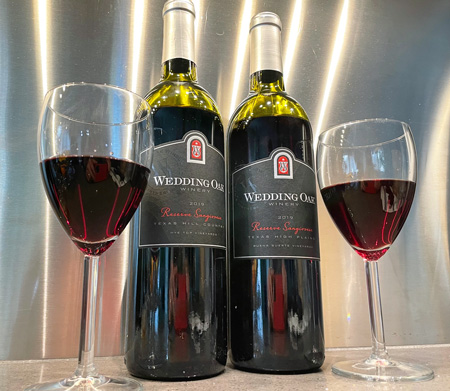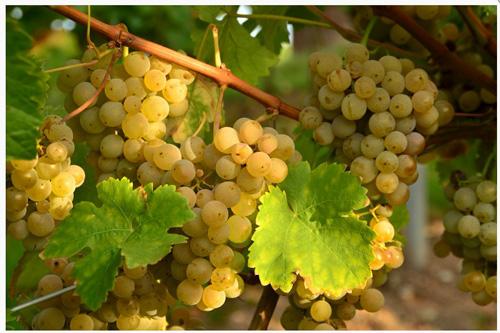
If you were in France and talked terroir with winegrowers there – for example in Burgundy, Wedding Oak Winery Winemaker Seth Urbanek says, “They will tell you that Pinot Noir at the top of the hill behaves differently, grows differently and will make a different wine than Pinot Noir grown in the same vineyard at the bottom of the hill. I think that we are at a really cool moment in the Texas wine scene where we are able to explore what Texas terroir really is.”
This is how Urbanek started his virtual wine tasting on Zoom that featured two wines made from the same grape – Sangiovese – made by the same winemaker (Seth) but from grapes grown in two different Texas regions: Texas High Plains and in the Texas Hill Country AVAs (American Viticultural Areas).

As you might know, the Texas High Plains AVA surrounds the Texas panhandle city of Lubbock. This region containes the center of Texas grape growing that is about an hour south of Lubbock in Terry County. This region is where about 70% of Texas wine grapes are grown. In contrast, the Texas Hill Country AVA is located in central Texas around the city of Fredericksburg. It has the highest concentration of wineries in the state, making it Texas’s winemaking capital. This region has been heralded by many including the folks at Wine Enthusiast who proclaim it Texas’s wine tourism center and “must see” wine region, also having its own increasing concentration of vineyards. Many hill country wineries like Wedding Oak, make wines from both Texas regions.
In summary, Seth’s “Texas terroir experiment” was to compare the wine characteristics of these two regions separated by about 350 miles and five hours of driving time. He presented his two wines (previously sent to the media group in the meeting) and asked us to taste and describe them noting similarities and differences. The wines were: Wedding Oak Winery, 2019 Reserve Sangiovese, Texas Hill Country, Hye Top Vineyard and 2019 Reserve Sangiovese, Texas High Plains, Buena Suerte Vineyard. Below are the integration of Seth’s winemaker notes, my tasting notes and sippets of our online interactions:
Wedding Oak Winery, 2019 Reserve Sangiovese, Texas Hill Country (THC), Hye Top Vineyard
The grapes for this wine were grown on sloping limestone soils that make this vineyard an extremely low yield site that produces concentrated fruit. The grapes were hand harvested, and in the cellar, were processed gently, and allowed to ferment in small batches in picking bins with minimal processing. After fermentation, the fruit was manually pressed, and the wine was then aged in 25% new French oak for 18 months. The finished wine yielded a dark ruby color and characteristics of fresh black cherry on the nose and palate with brambly notes followed by tobacco and baking spice, integrated with granular and firm tannins.
Wedding Oak Winery, 2019 Reserve Sangiovese, Texas High Plains (THP), Buena Suerte Vineyard.
These grapes were grown on THP typical sandy loam soils with porous caliche layer below, soils on which grapevines thrive allowing for higher grape yields. The fruit was machine picked and fermented in a stainless steel tank with the wine aged in 50% new Hungarian oak to add spice and depth. The wine has a shade lighter ruby color with characteristics of refreshing red cherry, cola, and dry earth along with light tannins.

From my tasting, I felt like Seth’s THC Sangiovese was a more substantial wine with deeper ruby color, darker cherry character, more substantial body, and a bit more rustic in nature than its high plains counterpart. That said, the high plains Sangiovese was a bit more dominant in tart and vibrant red cherry and lighter tannins than observed in the wine made from hill country grapes.
Reasons for these differences likely come from a multiple of sources like from classic considerations of terroir – vineyard soils and vine productivity, climate (cooler nights in THP and warmed in THC), and ultimately harvest ripeness and phenolic maturity. However, other considerations of cultural aspects and winemaker decisions are evident in these wines, as well. Examples are machine vs hand harvesting, transport from vineyard (time in transit), small-lot bin versus tank fermentation, and selection of barrel treatment (French versus Hungarian oak).
If I had to make a gross generalization about these two Sangioveses, it would be that the THC wine appeared to be riper and a bit bolder. In my opinion, both are excellent renditions of Texas Sangiovese but their differences would influence how and when I would pour and serve them. I would pair the THC wine with more intense foods like grilled ribeye steak or lamb. Whereas the THP wine could be a great sipping wine (in summer particularly if served slightly chilled) or paired with lighter cuisine like pasta primavera, or possibly grilled or baked chicken., or even an herb-butter-slathered, cast iron skillet-cooked Salmon steak.
I commend Seth for his attempt to explore Texas terroir with a giant step with one foot in the Texas high plains and the other foot in the hill country. Going forward, referenced in Seth’s comment about Burgundian terroir, Texas and its wine growers and winemakers like Seth will certainly be looking for differences closer at hand (or under foot) within AVAs that offer optimal growing conditions for new and existing grape varieties.


Be the first to comment